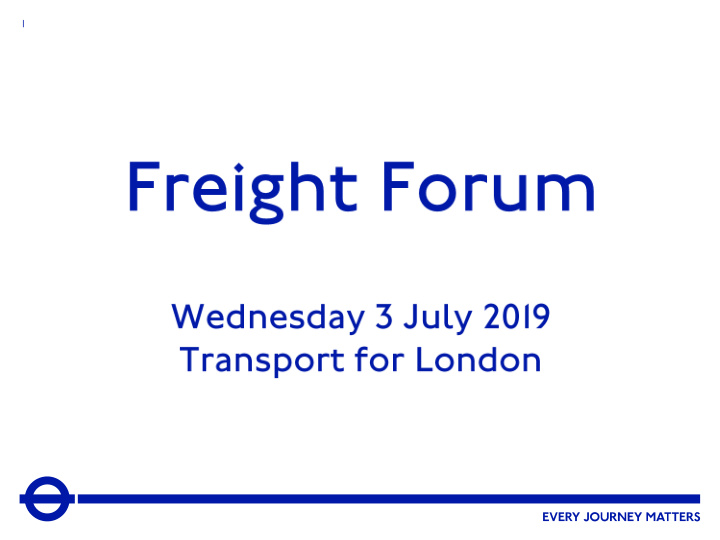



1
2
3
Compliance Feb 2017 May 2019 rates All vehicles 39% 74% HGVs 40% 87% Vans 9% 53%
5
6 6
7
8 Contents • • • • •
9 Vision Zero is central to Mayoral and TfL strategy and policy Minimising road danger is No loss of life Adopting Vision Zero fundamental to the is inevitable or ...will be central to the creation of streets where acceptable. overall success of the everyone feels safe Healthy Streets walking, cycling and using approach. public transport. I will adopt a ‘Vision Zero’ approach to road safety, which puts the elimination of road danger at the very heart of the transport system.
10 Ambitious targets for reducing KSIs using a Safe System approach The Vision Zero Action Plan is a plan to 2023/24 that focuses on intelligence-led action to reduce risk on our streets
11 Vision Zero and the Freight sector Between 2015 and 2017 there were 123 fatalities and 985 serious injuries involving goods vehicles on London’s streets , representing 32 per cent of the total number of people killed in collisions. Risk of motor vehicles being involved in fatal collisions with: people walking Locations of collisions involving goods vehicles resulting in deaths or serious injuries in London, 2015-2017 people cycling
12 Review of HGV fatalities, 2012-17 • TfL recently undertook analysis of fatal collisions in London involving HGVs and people walking, cycling and riding motorcycles • Based on 96 police collision investigation reports from 2012-2017 , with results as follows: Vehicle or driver non-compliance In 16% of fatal collisions, vehicle defects with the HGV, or a driving offence by the driver was a contributory factor. Driver age and experience Younger and less experienced drivers have slightly more chance of being involved in a fatal collision with someone walking, cycling or riding a motorcycle.
13 Review of HGV fatalities, 2012-17 (continued) Operators There is a disproportionate number of construction industry vehicles involved in fatal collisions with people walking, cycling and riding motorcycles in London. Vehicles operated by a company with FORS status are less likely to be discovered with a vehicle defect that contributed towards a fatal collision, than those without.
14 Review of HGV fatalities, 2012-17 (continued) Casualties Approximately half of the fatal collisions with cyclists occurred when the vehicle was making a left hand turn and a significantly large number of the freight vehicles were travelling at less than 10mph , suggesting that speeding or inappropriate speed is not a major contributory factor. Most pedestrian fatal collisions occur in slow moving traffic , suggesting HGVs using congested roads, in areas with large numbers of pedestrians, is a significant contributory factor in the collision. Motorcyclists between the age of 31 and 50 are more likely to be involved in a fatal collision with an HGV rather than any other type of vehicle.
15 Action to prevent HGV and older pedestrian casualties HGV-pedestrian fatalities All pedestrian fatalities The issue Elderly pedestrians have a significantly higher representation among fatal casualties involving HGVs. In 2019, three older pedestrians have been killed at the front of an HGV, whilst crossing in the vehicle’s blind spot. The response – an even-handed communications approach Bridging the gap between now and the longer term approach of the Direct Vision Standard, our approach is: • To older pedestrians - simple tips to keep safe around large vehicles. Through a leaflet, customer relationship management (CRM) and partnership activities with Age UK, we will be raising the awareness of the dangers of blind spots. • To HGV drivers - through the FORS newsletter and partner communications to raise awareness of the issue and alert them to high risk locations at Earl’s Court Road, Lea Bridge Road, Elephant & Castle, Brixton, Southall and Blackheath. • To all commercial drivers - CRM to raise awareness of the issue.
This complements the wider programme by TfL and partners to reduce danger from freight and servicing traffic • •
17 Summary HGVs continue to pose a • disproportionate risk to the most vulnerable people using London’s roads • Using a data-driven, intelligence-led approach using insights such as the latest HGV fatal analysis, we can ensure that resources are used more effectively to tackle the sources of danger • In order to achieve Vision Zero we must continue to work in partnership to reduce the risk that HGVs pose, whilst raising awareness of HGV danger to those most affected • We can all contribute more by challenging the highest risk behaviours, by those most responsible, at the locations that present greatest danger
18 Thank you Stuart Reid
3 July 2019 19 Direct Vision Standard & HGV Safety Permit
20 Background and context London has a particular issue with HGV and VRU collisions
21 The Direct Vision Standard
22 HGV safety permit scheme October 2019 Scheme ‘go - live’ >12t October 2020 0-star banned unless safe system met October 2024 2020 0-2 star banned unless progressive 2024 safe system met
23 Safe system
24 Applying for a Permit Step 1 – Do you require a permit? Step 2 – Find out your star rating Step 3 – Fit safe system (if 0 star rated) Step 4 – Apply for your permit
25 Permit application portal
26 Next Steps • Permits available from October 2019 • Permit enforcement will begin 26 October 2020 • Progressive Safe System consultation and stakeholder engagement 2022 Phase 2b 8 Jan 2019 Progressive safe system measures must be: Final proposals • Readily available on the market • Retrofittable at a proportionate cost • Recognised as industry best practice • Supported by evidence of effectiveness
27
Recommend
More recommend